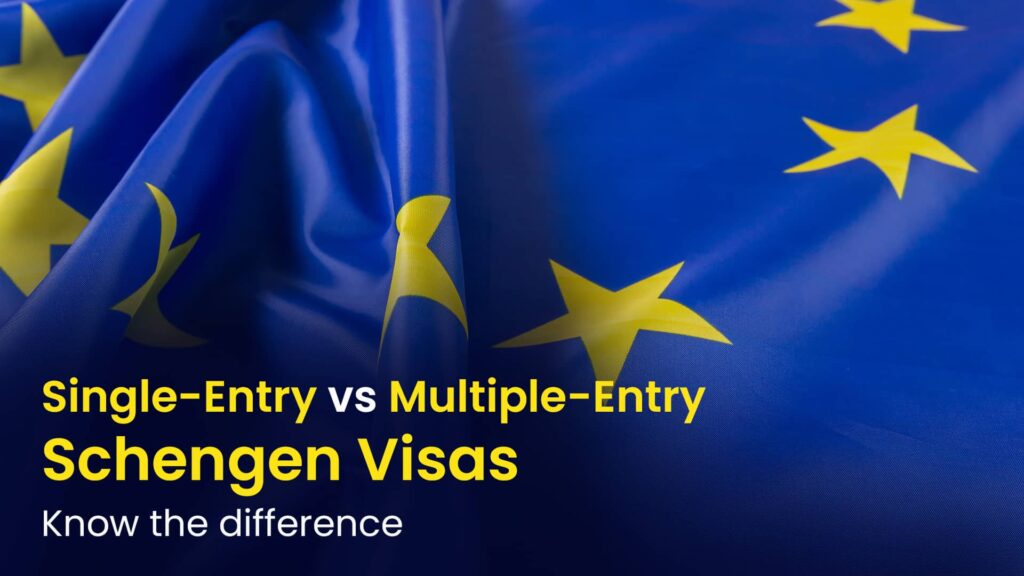Traversing across countries in the Schengen area requires a clear understanding of the diverse visa types available. Among these, the distinctions between single-entry, double-entry, and multiple-entry Schengen visas play a pivotal role in defining travelers’ access and stay. This blog will delve deeper into the nuances of each visa type, shedding light on their unique features and implications.
What is a Single Entry Schengen Visa?
A Single Entry Schengen Visa is a type of visa that permits travelers to enter the Schengen Area once within the specified validity period. This visa is suitable for individuals planning a one-time visit or a short-term stay in the Schengen Zone.
Once the visa holder enters the Schengen Area, the visa’s validity ceases, regardless of whether the approved duration of stay has been fully utilized. If the traveler exits the Schengen territory before the allowed duration elapses, the visa becomes invalid and cannot be used for re-entry.
The Single Entry Visa imposes restrictions on the number of times a traveler can enter the Schengen Zone. It is specifically designed for individuals with a defined itinerary, covering a single visit for purposes such as tourism, business meetings, or short-term educational programs.
Moreover, it’s essential for travelers holding a Single Entry Schengen Visa to plan their itineraries meticulously to ensure they make the most of their allowed stay. Any exit from the Schengen territory marks the end of the visa’s validity, irrespective of the duration of the intended stay.
Single Entry Schengen Visas are relatively straightforward to apply for, offering a simpler application process compared to multiple entry visas. They are cost-effective for travelers with a clear and singular purpose of visiting the Schengen Area for a limited period.
Double Entry Visa – What is it?
A Double Entry Schengen Visa, as the name suggests, grants travelers the privilege of entering the Schengen Area twice within the designated visa validity period. This type of visa is well-suited for individuals who plan to exit and re-enter the Schengen Zone on two separate occasions during their travels.
With a Double Entry Schengen Visa, travelers have the flexibility to depart and return to the Schengen territory twice, allowing them to plan a more dynamic travel itinerary compared to a single-entry visa.
This visa type serves individuals whose travel plans involve two distinct visits or transit through Schengen countries for specific purposes. It can be advantageous for those participating in business meetings, attending conferences, or exploring diverse destinations within the Schengen Area.
Similar to the Single Entry Visa, each entry into the Schengen Zone with a Double Entry Visa is subject to the regulations and allowed duration specified on the visa sticker. Once the second entry is utilized, the visa becomes invalid, even if the approved stay duration for the second entry has not been fully exhausted.
Multiple Entry Schengen Visa
The Multiple Entry Schengen Visa holds the key to unrestricted travel within the Schengen zone. With this visa, travelers have the liberty to come and go from the Schengen territory multiple times during the visa’s duration. This type of visa is particularly advantageous for frequent travelers who need to make repeated trips within the allotted visa validity.
Recommended Read: Different Types of Schengen Visas
Difference Between a Single-Entry Visa and Multiple-Entry Visas
Understanding the disparities between these visa types can significantly impact travel planning:
1. Number of Entries Allowed: Single-entry visas permit only one entry, while multiple-entry visas offer unrestricted entries during their validity.
2. Duration of Stay: Single-entry visas confine travelers to a specific period, whereas multiple-entry visas allow cumulative stays within their validity, respecting the individual stay duration limits.
3. Visa Validity: Single-entry visas expire upon exiting the Schengen area, while multiple-entry visas remain valid for the specified period, enabling multiple entries.
4. Other Considerations: Single-entry visas lose their validity after the first exit, whereas multiple-entry visas grant the flexibility of repeated entries within their authorized timeframe.
| Aspect | Single-Entry Visa | Multiple-Entry Visa |
| Number of Entries Allowed | One | Multiple |
| Duration of Stay | Limited to the approved period | Cumulative duration within visa validity |
| Visa Validity | Until the allowed stay ends | Specified period, multiple entries |
| Flexibility | Restricts travel to a single-entry | Offers flexibility for multiple entries |
| Exit Requirement | Expires after a single exit | No requirement to exit after each entry |
| Travel Frequency | Suitable for one-time trips | Ideal for frequent travelers and multiple trips |
| Administrative Ease | Simpler visa application process | May require more documentation for approval |
| Cost | €80 (adults), €40 (children 6-12) | €80 (adults), €40 (children 6-12) |
| Planning & Flexibility | Limited flexibility in travel plans | Allows for diverse travel itineraries |
| Ideal For | Single trips within visa validity | Frequent travel, business, and family ties |
| Processing Time | 15 calendar days | 15 calendar days |
| Risk of Overstay | Higher | Lower |
| Entry | One entry permitted | Multiple entries permitted within the visa validity |
Navigating the complexities of Schengen visas can be challenging. At The Visa Guy, we are dedicated to simplifying this process for our clients. Our team of experts is committed to assisting travelers in securing the right visa, ensuring a smooth and stress-free travel experience.
Understanding the intricacies of these visa types empowers travelers to make informed decisions. For a hassle-free visa processing experience, rely on The Visa Guy experts. Contact us today to begin your visa application process and embark on your Schengen adventure!
Frequently Asked Questions
1. Can I extend a Single-Entry Schengen Visa if I haven’t used it?
No, Schengen visas are non-extendable once issued, even if not utilized.
2. Can I apply directly for a Multiple Entry Schengen Visa?
You can request a multiple-entry visa, however, the visa decision lies with the respective embassy/consulate
3. What’s the maximum stay allowed on a Multiple Entry Schengen Visa?
The duration of stay on each entry should comply with the permitted days outlined on the visa sticker.
4. Is there a specific timeframe to apply for a Multiple Entry Schengen Visa after having a Single Entry Visa?
Generally, there isn’t a strict requirement, but it’s advisable to wait until the validity of the single-entry visa has expired before applying for a multiple-entry visa.
5. Can a Single Entry Visa be converted into a Multiple Entry Visa while in the Schengen area?
No, visa conversions are not permitted within the Schengen area. If there is a need for a multiple-entry visa, it should be applied for and obtained before entering the Schengen zone.
6. Are there limitations on the countries I can visit with a Multiple Entry Schengen Visa?
A Multiple Entry Schengen Visa allows entry into all countries within the Schengen Zone. However, it’s crucial to adhere to the individual country’s regulations regarding visa requirements and permitted duration of stay.



